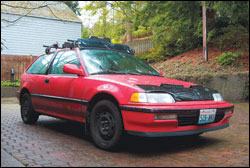I’VE ALWAYS ADMIRED the way young Asian guys take humble Japanese econoboxes (like mine) and turn them into hot rods. I love the throaty roar of the oversized tailpipes and the lowered chassis that bottom out on potholes and parking-lot ramps, leaving shards of brightly colored fiberglass like confetti on the pavement. I’ve always wondered what it would take to turn my redoubtable 1991 Honda Civic Si hatchback into a street racer.
Naturally my curiosity has led me to Burien, home of Charles Balch’s Pure Performance Innovations car shop (15020 Ambaum Blvd. S.W., 206-277-8676, www.ppiracing.com). Balch immediately praises my Si as “a good platform” for extensive mods. It’s not a heavy, electronics-laden luxury car; with its light, cheap frame, he explains, mine could be “just as fast as a Mustang.” Cool.
The original 108 horsepower engine obviously has to go, Balch tells me. But, thanks to the infinite wisdom of the Japanese government, which seeks to increase consumer spending with arcane regulations (motorists must replace their cars after a maximum allotment of years or miles), there’s a steady supply of powerful used engines that can yield about 170 horsepower. This gain also requires a beefier transmission, axles, and brakes. What you get is the wolf-in-sheep’s- clothing effect: the innocuous gas-sipper overlooked by both thieves and cops; the cheapo stealth vehicle that can suddenly spring past the Bimmer that costs four times as much.
THE LOWER THE CAR, the closer to God. Minimizing the ground clearance and adding stiffer springs is critical, Balch explains, to reduce the center of gravity (the opposite of tippy SUVs) and corner better. The present 5-inches ground clearance on my Honda is way too much, but a full suspension job with neat red- or blue-colored “coil-over” springshidden from public view, like silken shortswould allow me to raise or lower my car by 1 to 3 inches. Says Balch, my Si would then be “slammed.” SlammedI like the way that sounds.
Cars also look lower with the add-on fiberglass “body enhancements” that mimic ground-effects paneling (front, sides, rear), which actually helps race cars stick to the track. “It’s like dressing up your car,” Balch explains. But the effect is mainly cosmetic: “It might actually slow you down.”
Wheels? Bigger was better during the high-gloss, high-“floss” Latrell Sprewell era of the mid-’90s. My Si would permit 17-inch rims, but Balch is way too hip for that. He steers me instead toward lighter, faster 15-inch models in subdued tones of black, bronze, and gunmetal gray. I’m starting to get itthese do look cooler and more track-ready. Chrome is tired, and it adds weight, Balch adds, which is obviously bad.
THERE’S NO USE driving without being heard. The loud, oversized muffler craze originated in Japan (anything to stand out); here, tailpipes come in many big-“O” styles. But which to choose? Each has its own unique tone, Balch explains like a discerning musicianthe muffler is analogous to the bell of a French horn, but the “cat-back” (the long pipe connecting the muffler to the engine, where the catalytic converter goes) supplies the instrument’s real sound.
Take note, however: Chapter 25.08.450 of the Seattle Municipal Code decrees that “no person shall modify the exhaust system of a motor vehicle in a manner which will amplify or increase the noise emitted by the engine of such vehicle above that emitted by the muffler originally installed on the vehicle, and it shall be unlawful for any person to operate a motor vehicle . . . which has been amplified as prohibited by this section so that the vehicle’s exhaust noise exceeds ninety-five (95) decibels as measured by the Society of Automotive Engineers.”
Whoa. Back to the fun stufflike high-intensity discharge (HID) lights, those cool round taillights, snug, racer-style seats, a turbo kit (for more horsepower), plus maybe a stainless-steel fire extinguisher, just in case.
Total cost for turning my Honda into a street racer? About 13 grandmore than twice what I paid for it, used, a couple years ago. Why go to the cost and trouble? Because Civics, and all Japanese cars, are so popular, you want to stand out from utilitarian ubiquity. You can vary the degree of overt flash or covert speed to fit your personality. But mainly it’s because I hate the tinny rattling sound my car makes when I downshift from third to second. It’s just not . . . musical. Hmm. Ninety-five decibelsthat’s not so loud, is it?








